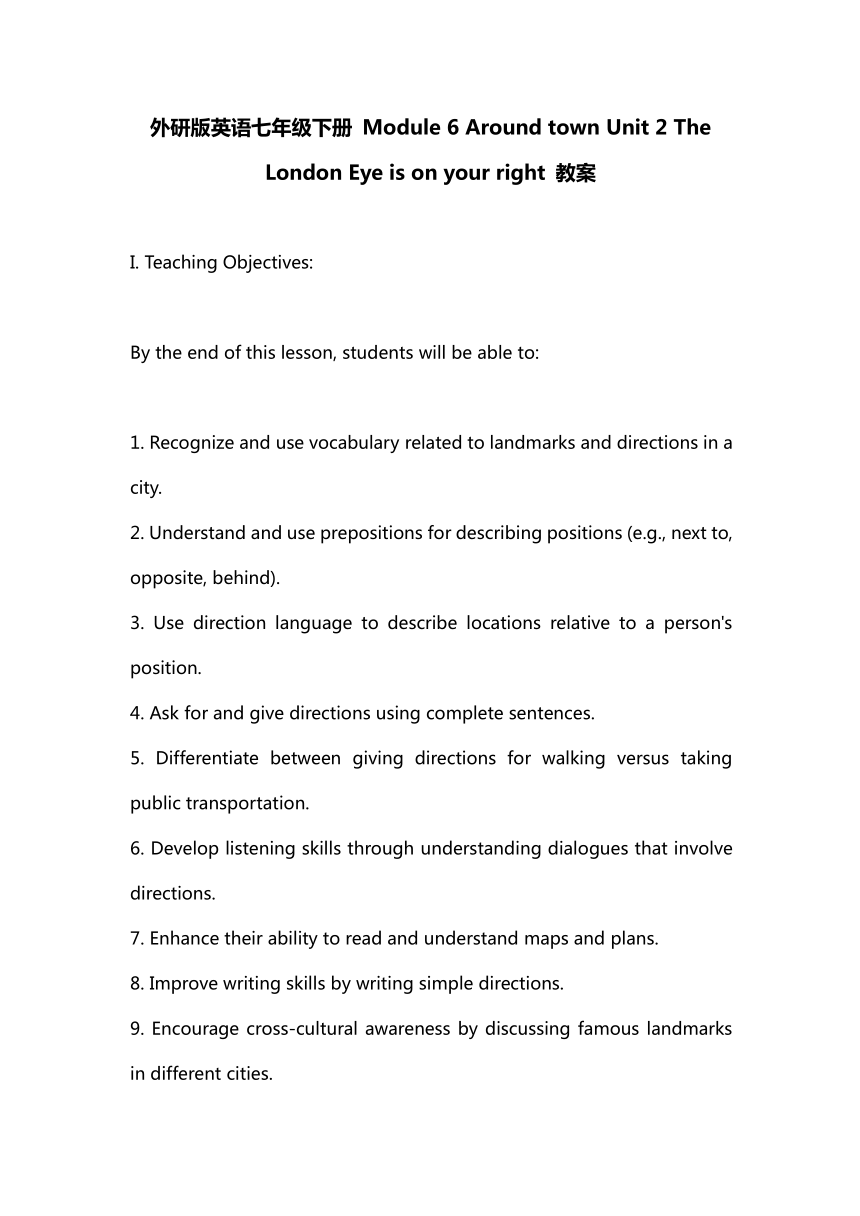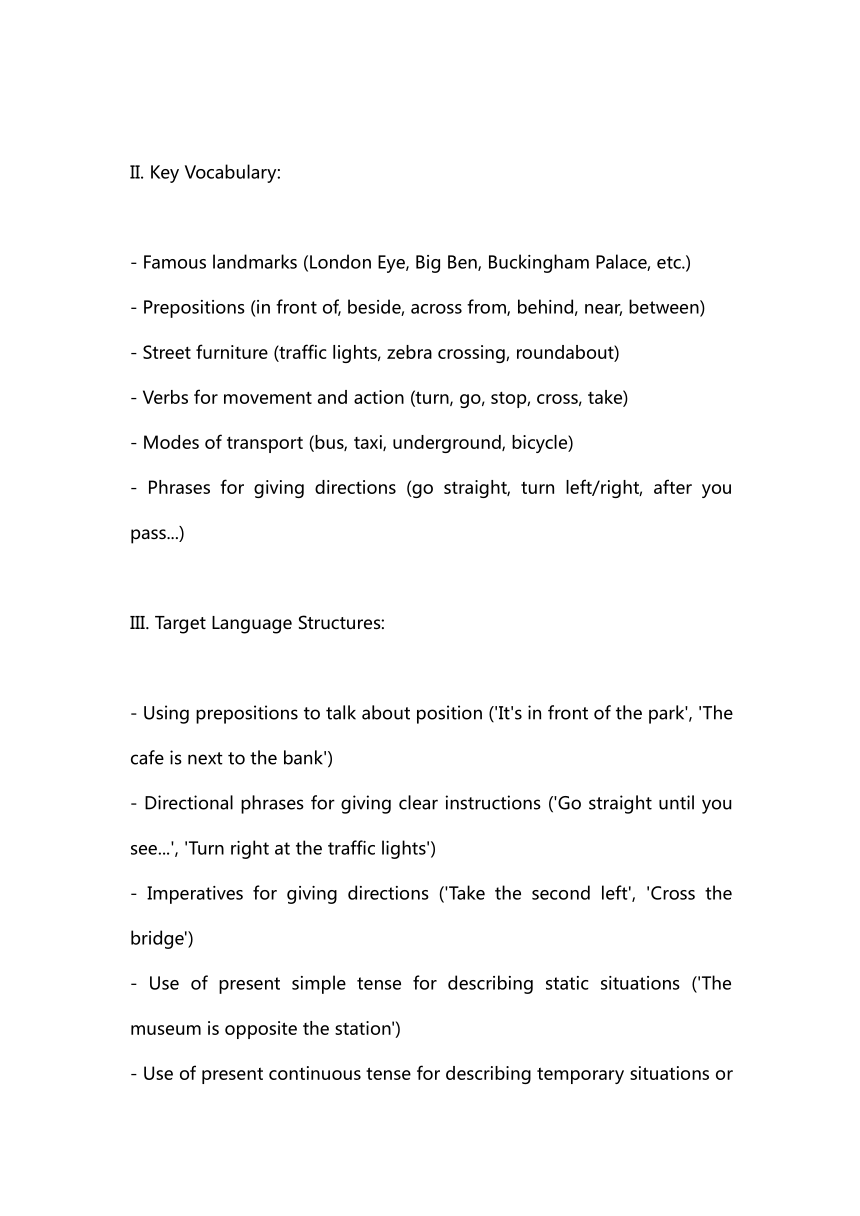Module 6 Unit 2 The London Eye is on your right. 教案 2023-2024学年外研版英语七年级下册
文档属性
| 名称 | Module 6 Unit 2 The London Eye is on your right. 教案 2023-2024学年外研版英语七年级下册 |  | |
| 格式 | docx | ||
| 文件大小 | 17.9KB | ||
| 资源类型 | 教案 | ||
| 版本资源 | 外研版 | ||
| 科目 | 英语 | ||
| 更新时间 | 2024-02-24 14:11:43 | ||
图片预览


文档简介
外研版英语七年级下册 Module 6 Around town Unit 2 The London Eye is on your right 教案
I. Teaching Objectives:
By the end of this lesson, students will be able to:
1. Recognize and use vocabulary related to landmarks and directions in a city.
2. Understand and use prepositions for describing positions (e.g., next to, opposite, behind).
3. Use direction language to describe locations relative to a person's position.
4. Ask for and give directions using complete sentences.
5. Differentiate between giving directions for walking versus taking public transportation.
6. Develop listening skills through understanding dialogues that involve directions.
7. Enhance their ability to read and understand maps and plans.
8. Improve writing skills by writing simple directions.
9. Encourage cross-cultural awareness by discussing famous landmarks in different cities.
II. Key Vocabulary:
- Famous landmarks (London Eye, Big Ben, Buckingham Palace, etc.)
- Prepositions (in front of, beside, across from, behind, near, between)
- Street furniture (traffic lights, zebra crossing, roundabout)
- Verbs for movement and action (turn, go, stop, cross, take)
- Modes of transport (bus, taxi, underground, bicycle)
- Phrases for giving directions (go straight, turn left/right, after you pass...)
III. Target Language Structures:
- Using prepositions to talk about position ('It's in front of the park', 'The cafe is next to the bank')
- Directional phrases for giving clear instructions ('Go straight until you see...', 'Turn right at the traffic lights')
- Imperatives for giving directions ('Take the second left', 'Cross the bridge')
- Use of present simple tense for describing static situations ('The museum is opposite the station')
- Use of present continuous tense for describing temporary situations or events ('You're currently next to the library')
IV. Teaching Aids:
- Maps of London and other major cities with labeled landmarks.
- Realia such as small models of landmarks, buses, taxis, etc.
- Pictures of street signs and traffic signals.
- Whiteboard and markers for drawing quick maps and illustrating directions.
- Role-play props like hats or badges to identify tourists, locals, police, etc.
- Audio materials featuring conversations about giving and receiving directions.
- Handouts with exercises and a map for students to fill in directions.
V. Teaching Procedures:
Step 1: Warm-up (5 minutes)
- Engage students with a discussion about their favorite landmarks in their own city or abroad.
- Elicit some key vocabulary related to landmarks and directions.
Step 2: Listening (10 minutes)
- Play an audio track where someone is asking for directions around London. Have students listen and then answer comprehension questions.
Step 3: Speaking Practice (15 minutes)
- Students work in pairs to practice a conversation where one person asks for directions and the other gives them.
- Introduce role-playing scenarios where students enact tourists and locals giving and receiving directions.
Step 4: Map Reading (10 minutes)
- Distribute maps of London and guide students through reading and understanding key landmarks and streets.
- In groups, have students discuss how to get from one landmark to another using the map.
Step 5: Writing Task (10 minutes)
- Ask students to write down directions from one place to another using the landmarks they learned and the target language structures.
- Encourage them to be as clear and detailed as possible in their instructions.
Step 6: Homework & Review (5 minutes)
- Assign homework where students create a short dialogue involving directions within their own city.
- Review the lesson by playing a quick game where students race to correctly name landmarks and give directions.
VI. Assessment:
- Evaluate students based on their participation in class discussions, correct use of vocabulary during speaking practice, accuracy in map reading tasks, and clarity of written directions.
- Assess understanding of the target language structures by evaluating students' ability to give clear, accurate directions using the imperative form and prepositions of place.
I. Teaching Objectives:
By the end of this lesson, students will be able to:
1. Recognize and use vocabulary related to landmarks and directions in a city.
2. Understand and use prepositions for describing positions (e.g., next to, opposite, behind).
3. Use direction language to describe locations relative to a person's position.
4. Ask for and give directions using complete sentences.
5. Differentiate between giving directions for walking versus taking public transportation.
6. Develop listening skills through understanding dialogues that involve directions.
7. Enhance their ability to read and understand maps and plans.
8. Improve writing skills by writing simple directions.
9. Encourage cross-cultural awareness by discussing famous landmarks in different cities.
II. Key Vocabulary:
- Famous landmarks (London Eye, Big Ben, Buckingham Palace, etc.)
- Prepositions (in front of, beside, across from, behind, near, between)
- Street furniture (traffic lights, zebra crossing, roundabout)
- Verbs for movement and action (turn, go, stop, cross, take)
- Modes of transport (bus, taxi, underground, bicycle)
- Phrases for giving directions (go straight, turn left/right, after you pass...)
III. Target Language Structures:
- Using prepositions to talk about position ('It's in front of the park', 'The cafe is next to the bank')
- Directional phrases for giving clear instructions ('Go straight until you see...', 'Turn right at the traffic lights')
- Imperatives for giving directions ('Take the second left', 'Cross the bridge')
- Use of present simple tense for describing static situations ('The museum is opposite the station')
- Use of present continuous tense for describing temporary situations or events ('You're currently next to the library')
IV. Teaching Aids:
- Maps of London and other major cities with labeled landmarks.
- Realia such as small models of landmarks, buses, taxis, etc.
- Pictures of street signs and traffic signals.
- Whiteboard and markers for drawing quick maps and illustrating directions.
- Role-play props like hats or badges to identify tourists, locals, police, etc.
- Audio materials featuring conversations about giving and receiving directions.
- Handouts with exercises and a map for students to fill in directions.
V. Teaching Procedures:
Step 1: Warm-up (5 minutes)
- Engage students with a discussion about their favorite landmarks in their own city or abroad.
- Elicit some key vocabulary related to landmarks and directions.
Step 2: Listening (10 minutes)
- Play an audio track where someone is asking for directions around London. Have students listen and then answer comprehension questions.
Step 3: Speaking Practice (15 minutes)
- Students work in pairs to practice a conversation where one person asks for directions and the other gives them.
- Introduce role-playing scenarios where students enact tourists and locals giving and receiving directions.
Step 4: Map Reading (10 minutes)
- Distribute maps of London and guide students through reading and understanding key landmarks and streets.
- In groups, have students discuss how to get from one landmark to another using the map.
Step 5: Writing Task (10 minutes)
- Ask students to write down directions from one place to another using the landmarks they learned and the target language structures.
- Encourage them to be as clear and detailed as possible in their instructions.
Step 6: Homework & Review (5 minutes)
- Assign homework where students create a short dialogue involving directions within their own city.
- Review the lesson by playing a quick game where students race to correctly name landmarks and give directions.
VI. Assessment:
- Evaluate students based on their participation in class discussions, correct use of vocabulary during speaking practice, accuracy in map reading tasks, and clarity of written directions.
- Assess understanding of the target language structures by evaluating students' ability to give clear, accurate directions using the imperative form and prepositions of place.
同课章节目录
- Module 1 Lost and found
- Unit 1 Whose bag is this?
- Unit 2 Are they yours?
- Unit 3 Language in use
- Module 2 What can you do ?
- Unit 1 I can play the piano
- Unit 2 I can run really fast
- Unit 3 Language in use
- Module 3 Making plans
- Unit 1 What are you going to do at the weekends?
- Unit 2 We're going to cheer the players.
- Unit 3 Language in use
- Module 4 Life in the future
- Unit 1 Everyone will study at home
- Unit 2 Every family will have a small plane.
- Unit 3 Language in use
- Module 5 Shopping
- Unit 1 What can I do for you?
- Unit 2 You can buy everything on the Internet
- Unit 3 Language in use
- Module 6 Around town
- Unit 1 Could you tell me how to get to the Nationa
- Unit 2 The London Eye is on your right.
- Unit 3 Language in use
- Revision module A
- Module 7 My past life
- Unit 1 I was born in a small village.
- Unit 2 I was born in Quincy.
- Unit 3 Language in use
- Module 8 Story time
- Unit 1 Once upon a time….
- Unit 2 Goldilocks hurried out of the house.
- Unit 3 Language in use
- Module 9 Life history
- Unit 1 He left school and began work at the age of
- Unit 2 He decided to be an actor.
- Unit 3 Language in use
- Module 10 A holiday journey
- Unit 1 What did you do?
- Unit 2 This morning we took a walk.
- Unit 3 Language in use
- Module 11 Body language
- Unit 1 They touch noses!
- Unit 2 Here are some ways to welcome them.
- Unit 3 Language in use
- Module 12 Western music
- Unit 1 It's so beautiful!
- Unit 2 Vienna is the centre of European classical
- Unit 3 Language in use
- Revision module B
